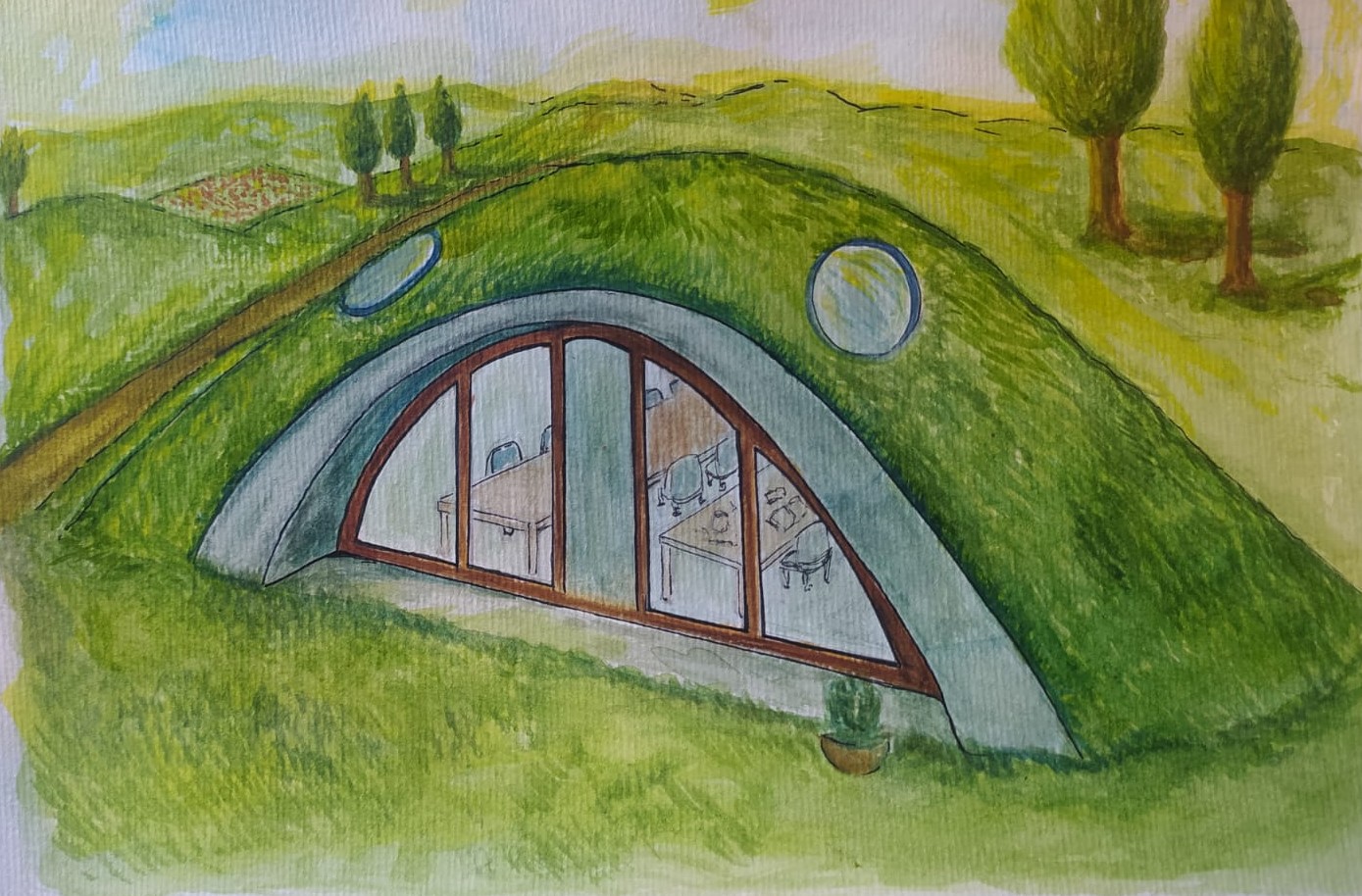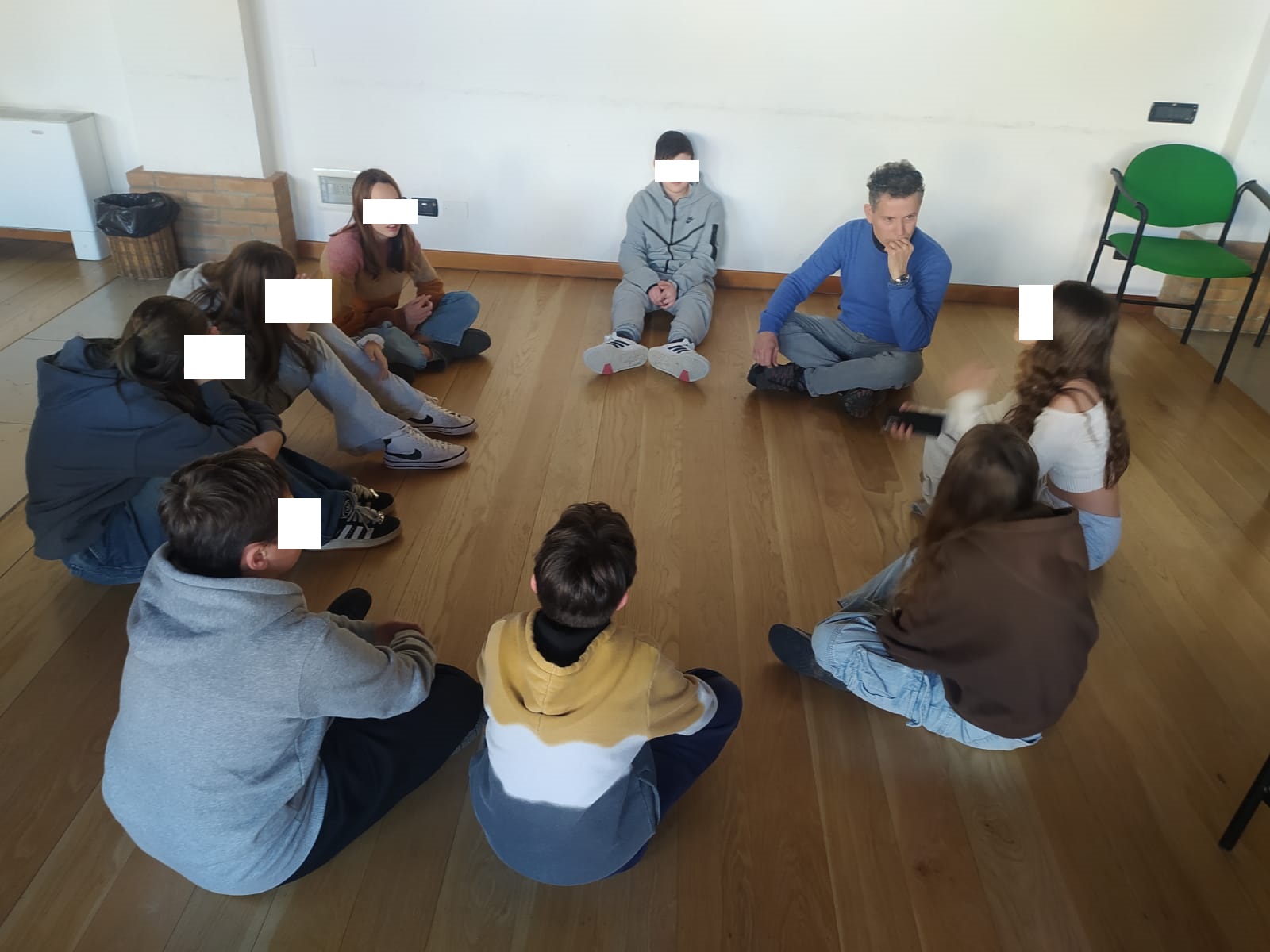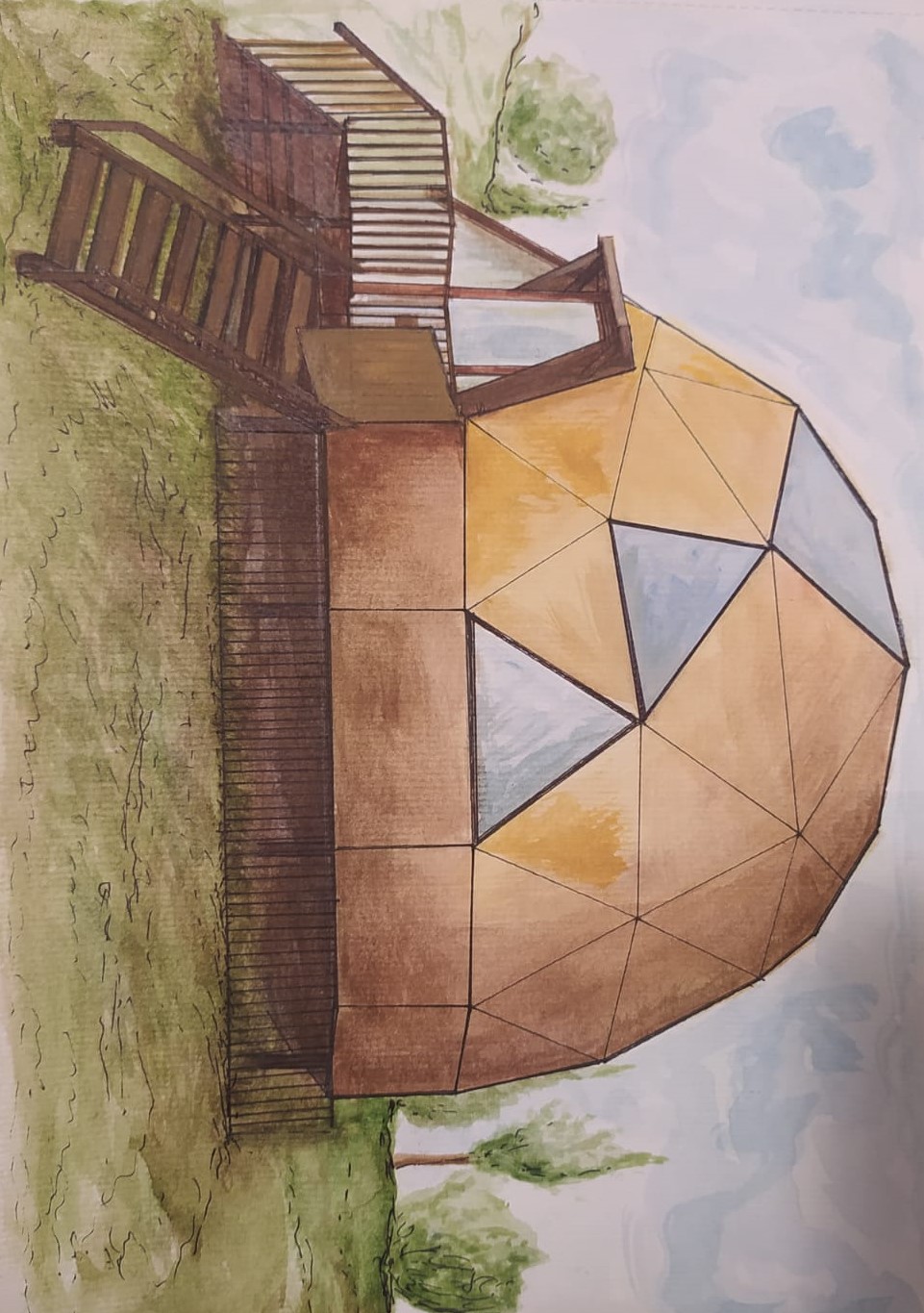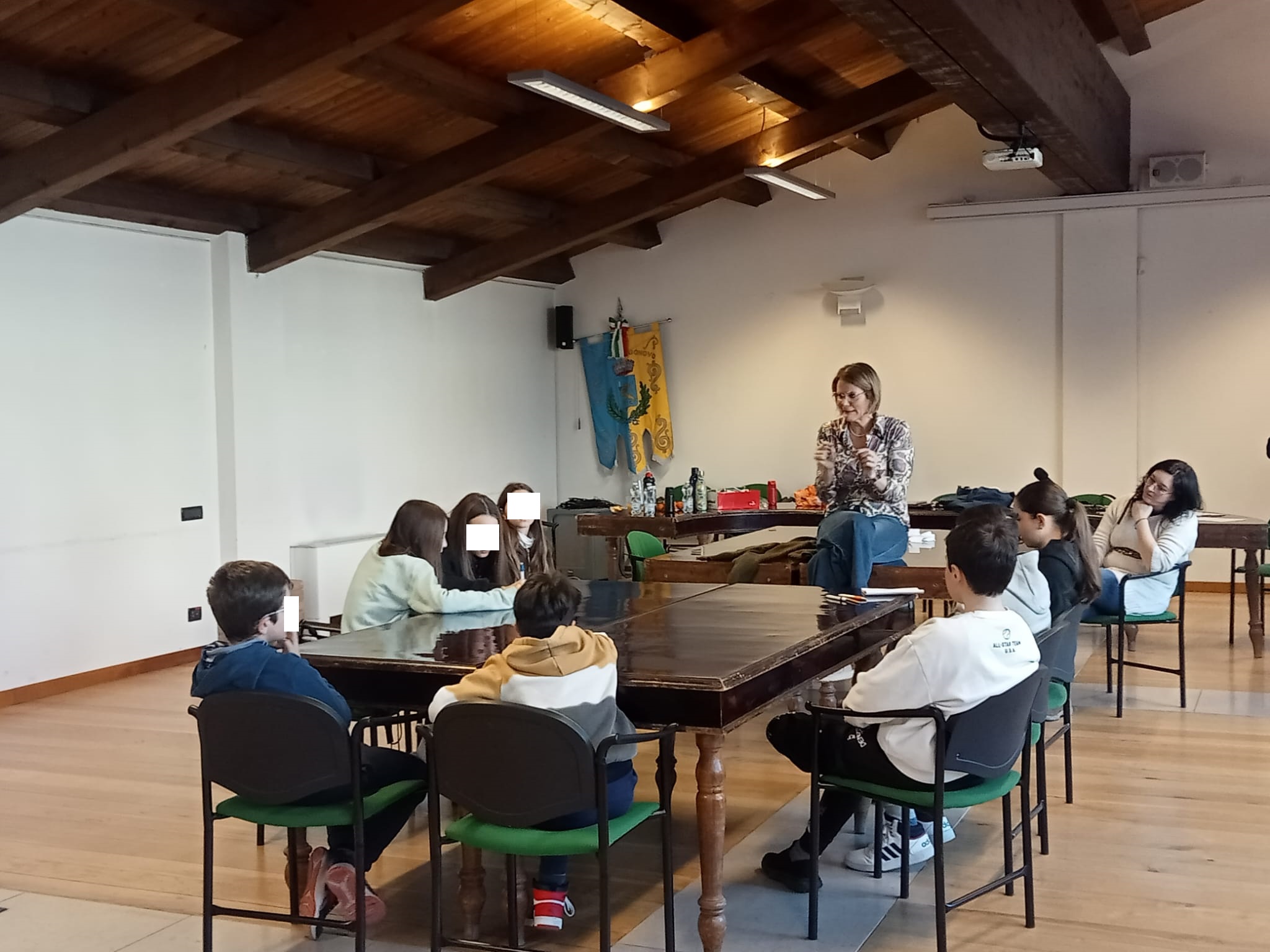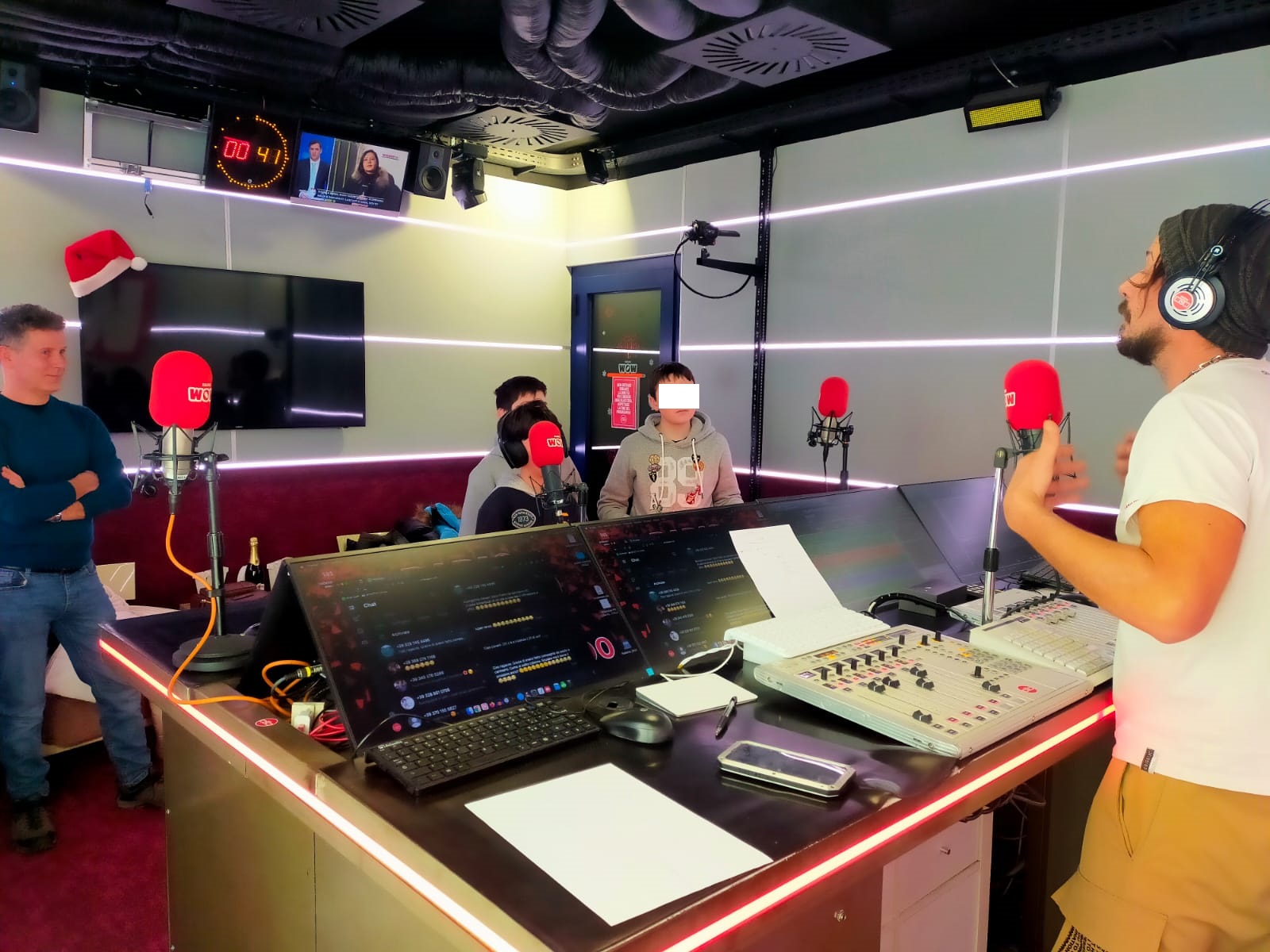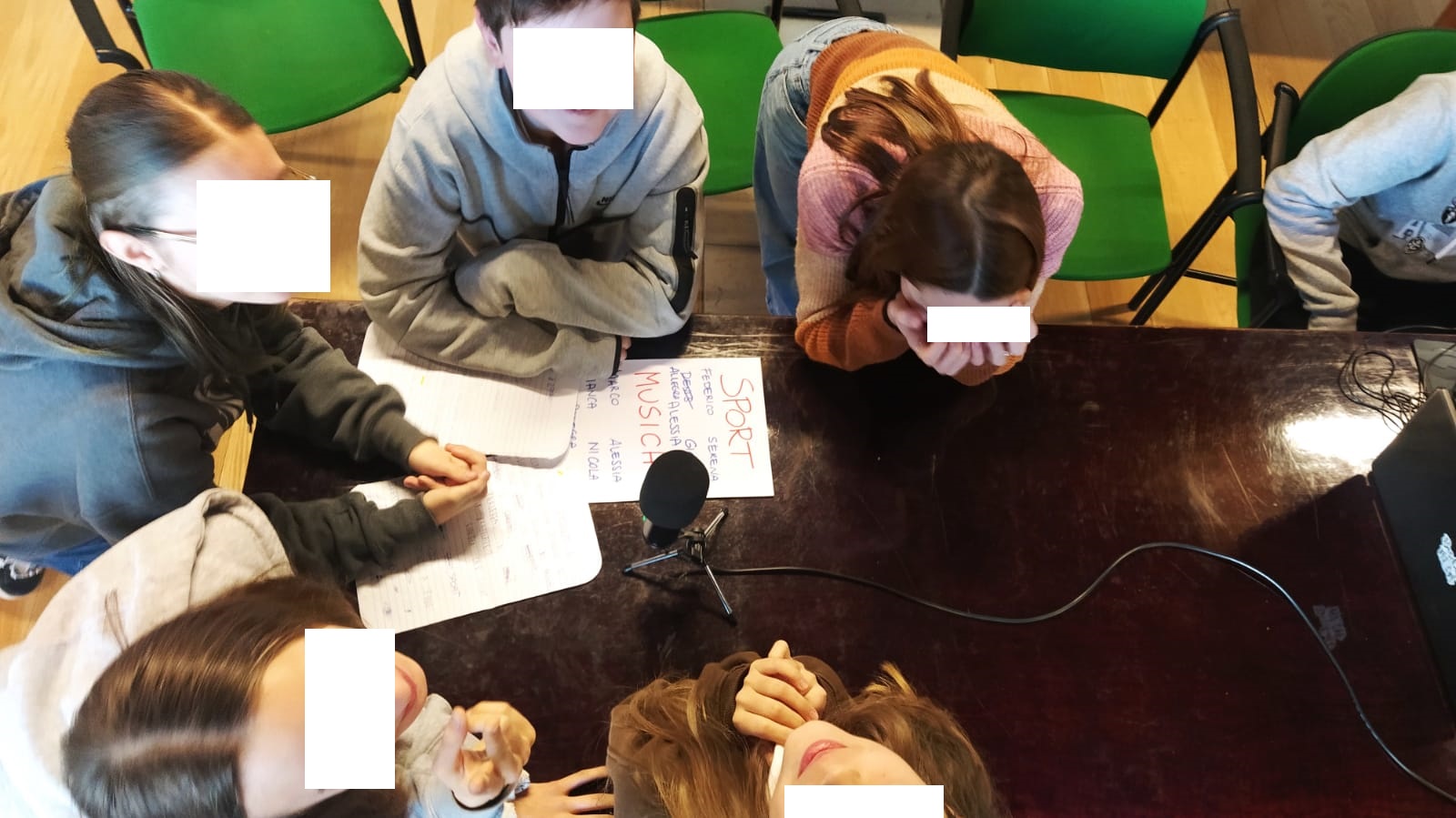Regaining a sense of belonging
REVOLUTION - The Podcast for Young
REVOLUTION is a podcast that promotes effective communication between young people and adults.
The podcast workshop for young people is a creative space where they can experiment with podcast production, becoming authors, speakers, and editing technicians. Through writing, recording, and audio editing, participants develop communication, expressive, and collaboration skills, engaging in authentic and captivating interactions with their peers.
Italy
Local
Vigonovo and nearby cities: Padova and Venezia
Mainly rural
It refers to other types of transformations (soft investment)
Yes
2024-12-30
No
No
No
As a representative of an organisation
Location: Vigonovo
Duration: 4 days
Dates: December 27-28-29-30, 2024
Participants: 10 young people aged 10-15
Organizer: Germoglio Novo APS
Overall Objective:
The workshop aimed to develop effective communication skills among participants, promoting active listening, expressing opinions, and constructive dialogue. It also sought to encourage reflection on topics relevant to preadolescents, improving communication within families.
Specific Objectives:
Enhance oral and written communication skills.
Foster active listening and self-awareness.
Promote intergenerational dialogue with families.
Develop skills in podcast production.
Activities and Outcomes:
Day One:
A journalist introduced effective interviewing techniques, and the participants chose podcast themes (animals, social media, sports, music). They worked in groups to develop questions.
Day Two:
Recording the podcast allowed the participants to reflect on sensitive topics like the loss of pets, cyberbullying, encouragement in sports, and expressing personal tastes. They gained skills in recording and editing audio.
Day Three:
Families were invited to listen to the podcast on Spotify. Then, with the help of a counselor, the young people interviewed their family members, stimulating dialogue and intergenerational exchange.
Day Four:
The participants had the opportunity to join a live radio broadcast at Radio Wow, where they applied the skills they had learned, improving microphone handling and improvisation.
Conclusions:
The workshop represented a valuable growth opportunity, fostering listening and dialogue. The project's success is evident in the Spotify podcast and the radio experience, contributing to the development of more self-aware and communicative young people.
Duration: 4 days
Dates: December 27-28-29-30, 2024
Participants: 10 young people aged 10-15
Organizer: Germoglio Novo APS
Overall Objective:
The workshop aimed to develop effective communication skills among participants, promoting active listening, expressing opinions, and constructive dialogue. It also sought to encourage reflection on topics relevant to preadolescents, improving communication within families.
Specific Objectives:
Enhance oral and written communication skills.
Foster active listening and self-awareness.
Promote intergenerational dialogue with families.
Develop skills in podcast production.
Activities and Outcomes:
Day One:
A journalist introduced effective interviewing techniques, and the participants chose podcast themes (animals, social media, sports, music). They worked in groups to develop questions.
Day Two:
Recording the podcast allowed the participants to reflect on sensitive topics like the loss of pets, cyberbullying, encouragement in sports, and expressing personal tastes. They gained skills in recording and editing audio.
Day Three:
Families were invited to listen to the podcast on Spotify. Then, with the help of a counselor, the young people interviewed their family members, stimulating dialogue and intergenerational exchange.
Day Four:
The participants had the opportunity to join a live radio broadcast at Radio Wow, where they applied the skills they had learned, improving microphone handling and improvisation.
Conclusions:
The workshop represented a valuable growth opportunity, fostering listening and dialogue. The project's success is evident in the Spotify podcast and the radio experience, contributing to the development of more self-aware and communicative young people.
Development of communication skills: Enhance oral and written communication skills among participants, improving the expression of opinions and dialogue management.
Active listening and self-awareness: Stimulate active listening and self-awareness, promoting more empathetic and reflective communication.
Intergenerational dialogue: Foster dialogue and connection between generations by involving participants' families.
Reflection on relevant topics: Encourage reflection on important issues for preadolescents, such as emotions, socialization, and emotional self-sufficiency.
Technical skills in content creation: Develop practical skills in podcast creation and editing, allowing participants to express themselves creatively and technically.
The effective communication workshop had a significant impact, focusing on social, cultural, educational, and environmental sustainability. It promoted intergenerational dialogue between participants and their families, strengthening communication and creating a space for mutual listening. The educational approach encouraged reflection on relevant topics for the young participants, improving their communication skills, while practical activities like podcast creation offered new opportunities for technical and creative learning.
Thanks to its flexible structure, the workshop is easily replicable in schools. The ability to adapt the activities to school curricula and the involvement of experts make this project scalable, thus expanding its educational impact and engaging more young people in formative activities that enhance their communication abilities. Its applicability in various educational contexts ensures that more students can benefit from a similar experience.
The success of the project and the Germoglio Novo APS association paves the way for the evolution of the workshop through environmental sustainability. Creating a dedicated area within a park will be a natural and necessary outcome of the project. This space, designed to host educational activities, will provide participants with a meeting place that respects local natural resources, contributing to environmental awareness. Developing an educational park will not only complement the workshop’s formative aspect but will also further establish a sustainable project that will grow over time, educating future generations on effective communication and respect for natural resources.
Thanks to its flexible structure, the workshop is easily replicable in schools. The ability to adapt the activities to school curricula and the involvement of experts make this project scalable, thus expanding its educational impact and engaging more young people in formative activities that enhance their communication abilities. Its applicability in various educational contexts ensures that more students can benefit from a similar experience.
The success of the project and the Germoglio Novo APS association paves the way for the evolution of the workshop through environmental sustainability. Creating a dedicated area within a park will be a natural and necessary outcome of the project. This space, designed to host educational activities, will provide participants with a meeting place that respects local natural resources, contributing to environmental awareness. Developing an educational park will not only complement the workshop’s formative aspect but will also further establish a sustainable project that will grow over time, educating future generations on effective communication and respect for natural resources.
The project aimed to create an aesthetically engaging and high-quality experience for the participants, promoting authentic and stimulating interaction through the use of technology and expert input. The activities were designed to encourage the creativity of the participants, allowing them to explore relevant topics in a meaningful way.
High-quality technology for an immersive experience:
The use of professional microphones, PCs, and editing software ensured a hands-on and high-quality experience. The podcast creation, uploaded to platforms like Spotify, allowed the participants to see the result of their work in a real-world context, reinforcing the value of the experience.
Expert encounters and professional exchange:
The involvement of journalists, counselors, and radio speakers enriched the cultural experience, providing participants with practical tools for conducting interviews, managing emotions, and hosting radio shows. These experts expanded the young people's cultural horizons by offering a concrete view of communication-related professions.
Hands-on experience in live radio broadcasting:
The visit to radio studios represented a significant growth moment. Participants had the opportunity to see professional technology in use and take part in a live radio broadcast as speakers. This experience boosted the students' confidence in their abilities, leading them to return to school excited and ready to share their experiences.
Exemplarity of the Project:
The project is exemplary as it combines technology, culture, and practical experience, engaging the participants on a technical, creative, and emotional level. The blend of advanced tools, hands-on activities, and expert input created a comprehensive educational experience. The workshop represents a model that can easily be replicated in other contexts, offering a concrete example of how education can integrate technological innovation and cultural growth.
High-quality technology for an immersive experience:
The use of professional microphones, PCs, and editing software ensured a hands-on and high-quality experience. The podcast creation, uploaded to platforms like Spotify, allowed the participants to see the result of their work in a real-world context, reinforcing the value of the experience.
Expert encounters and professional exchange:
The involvement of journalists, counselors, and radio speakers enriched the cultural experience, providing participants with practical tools for conducting interviews, managing emotions, and hosting radio shows. These experts expanded the young people's cultural horizons by offering a concrete view of communication-related professions.
Hands-on experience in live radio broadcasting:
The visit to radio studios represented a significant growth moment. Participants had the opportunity to see professional technology in use and take part in a live radio broadcast as speakers. This experience boosted the students' confidence in their abilities, leading them to return to school excited and ready to share their experiences.
Exemplarity of the Project:
The project is exemplary as it combines technology, culture, and practical experience, engaging the participants on a technical, creative, and emotional level. The blend of advanced tools, hands-on activities, and expert input created a comprehensive educational experience. The workshop represents a model that can easily be replicated in other contexts, offering a concrete example of how education can integrate technological innovation and cultural growth.
The project aimed to foster inclusion by ensuring equal opportunities for all participants, removing economic and social barriers, and creating an environment where everyone could express themselves freely. Families were actively involved, enhancing intergenerational dialogue and strengthening family communication.
Accessibility and Affordability for All:
The workshop was designed to be accessible to a wide range of participants, including those with limited resources. The activities were free of charge, eliminating financial barriers. It was held during school holidays, allowing students to participate without interfering with their school schedules.
Inclusive Governance and Active Participation:
The project encouraged participation by allowing students to contribute to activity choices. Each group selected interview topics and decided on the podcast format, fostering ownership. Students actively listened to one another, promoting respect. Families were invited to listen to the podcast and engage in interviews, strengthening family communication.
Design Principles for All:
The project considered participants' diversity, ensuring everyone had the resources to express themselves. It was structured to include students with varying communication skills, promoting an inclusive environment. Creating the podcast allowed them to express themselves using both verbal and technological skills.
Exemplarity of the Project:
The project exemplifies inclusion by integrating it at every stage, making the experience accessible and engaging for all. Offering a free workshop that promoted communication among students from different backgrounds is a clear example of inclusive education. Involving families added further value. This model shows how education can bridge socio-economic and cultural gaps, creating opportunities for growth and participation for all.
Accessibility and Affordability for All:
The workshop was designed to be accessible to a wide range of participants, including those with limited resources. The activities were free of charge, eliminating financial barriers. It was held during school holidays, allowing students to participate without interfering with their school schedules.
Inclusive Governance and Active Participation:
The project encouraged participation by allowing students to contribute to activity choices. Each group selected interview topics and decided on the podcast format, fostering ownership. Students actively listened to one another, promoting respect. Families were invited to listen to the podcast and engage in interviews, strengthening family communication.
Design Principles for All:
The project considered participants' diversity, ensuring everyone had the resources to express themselves. It was structured to include students with varying communication skills, promoting an inclusive environment. Creating the podcast allowed them to express themselves using both verbal and technological skills.
Exemplarity of the Project:
The project exemplifies inclusion by integrating it at every stage, making the experience accessible and engaging for all. Offering a free workshop that promoted communication among students from different backgrounds is a clear example of inclusive education. Involving families added further value. This model shows how education can bridge socio-economic and cultural gaps, creating opportunities for growth and participation for all.
The project had a significant impact on the local community, engaging participants, families, citizens, and professionals, fostering collaboration. The inclusion of civil society was crucial for its success.
Involvement of Families:
Families were actively involved, especially on the third day when they were invited to listen to the podcast and participate in interviews with their children. This reinforced family and intergenerational dialogue, improving communication between parents and children and strengthening ties with the community.
Contribution of Local Experts and Professionals:
Local professionals, such as the journalist, counselor, and radio speaker, enhanced the project with their expertise, supporting the participants' practical learning. Their involvement elevated the workshop’s quality, making it both engaging and educational.
Visit to the Radio Station and Community Integration:
Participants visited Radio Wow, explored broadcasting technology, and participated in a live broadcast as speakers. This experience connected them to the radio world and deepened ties with the local community, expanding audience involvement.
Contribution of Association Volunteers:
Germoglio Novo APS volunteers played a key role in helping participants overcome shyness. Their support enabled the participants to express themselves with more confidence, boosting communication and personal skills.
Impact on the Community:
The involvement of citizens and professionals created a strong link between the workshop and civil society. Participants developed civic awareness, and families shared a growth experience, strengthening social bonds and generating a positive ripple effect within the community.
Role and Level of Involvement:
Families, professionals, and volunteers were essential in providing support and resources. The project fostered education beyond the classroom, creating a network of educators, families, professionals, and local volunteers.
Involvement of Families:
Families were actively involved, especially on the third day when they were invited to listen to the podcast and participate in interviews with their children. This reinforced family and intergenerational dialogue, improving communication between parents and children and strengthening ties with the community.
Contribution of Local Experts and Professionals:
Local professionals, such as the journalist, counselor, and radio speaker, enhanced the project with their expertise, supporting the participants' practical learning. Their involvement elevated the workshop’s quality, making it both engaging and educational.
Visit to the Radio Station and Community Integration:
Participants visited Radio Wow, explored broadcasting technology, and participated in a live broadcast as speakers. This experience connected them to the radio world and deepened ties with the local community, expanding audience involvement.
Contribution of Association Volunteers:
Germoglio Novo APS volunteers played a key role in helping participants overcome shyness. Their support enabled the participants to express themselves with more confidence, boosting communication and personal skills.
Impact on the Community:
The involvement of citizens and professionals created a strong link between the workshop and civil society. Participants developed civic awareness, and families shared a growth experience, strengthening social bonds and generating a positive ripple effect within the community.
Role and Level of Involvement:
Families, professionals, and volunteers were essential in providing support and resources. The project fostered education beyond the classroom, creating a network of educators, families, professionals, and local volunteers.
The project benefited from the active involvement of key stakeholders, who contributed their expertise and resources, enriching the overall experience and ensuring its success.
Sara Patron, Journalist and Writer (Local Level):
Sara Patron introduced participants to the art of interviewing, providing guidance on creating engaging questions and enhancing communication skills. Her involvement encouraged participants to develop their interview abilities.
Daria Belmonte, Counselor (Local Level):
Daria Belmonte worked with families, facilitating intergenerational dialogue. She supported both parents and participants in addressing sensitive topics, improving communication, and strengthening family relationships.
Francesco Galante, Radio Speaker (Local Level):
Francesco Galante guided participants in effective voice use, enhancing their oratory skills and podcast preparation. His experience ensured the quality of the final product.
Stefano Mattara, Director of Radio Wow (Local Level):
Stefano Mattara allowed participants to visit the radio studios, providing hands-on learning. His support connected them with the media world, increasing the project’s visibility.
Andrea Meggio, Radio Speaker at Radio Wow (Local Level):
Andrea Meggio guided participants during the live radio broadcast, helping them interact with media professionals and improve public speaking skills.
Sabrina Dorio, Councillor for Social and Youth Policies, Municipality of Vigonovo (Local Level):
Sabrina Dorio supported the project with institutional backing, ensuring its visibility and relevance within local youth policies.
Added Value of Stakeholder Involvement:
These stakeholders enriched the project by offering participants a well-rounded experience combining media skills and personal growth. Their support extended the project’s reach and strengthened its local foundation.
Sara Patron, Journalist and Writer (Local Level):
Sara Patron introduced participants to the art of interviewing, providing guidance on creating engaging questions and enhancing communication skills. Her involvement encouraged participants to develop their interview abilities.
Daria Belmonte, Counselor (Local Level):
Daria Belmonte worked with families, facilitating intergenerational dialogue. She supported both parents and participants in addressing sensitive topics, improving communication, and strengthening family relationships.
Francesco Galante, Radio Speaker (Local Level):
Francesco Galante guided participants in effective voice use, enhancing their oratory skills and podcast preparation. His experience ensured the quality of the final product.
Stefano Mattara, Director of Radio Wow (Local Level):
Stefano Mattara allowed participants to visit the radio studios, providing hands-on learning. His support connected them with the media world, increasing the project’s visibility.
Andrea Meggio, Radio Speaker at Radio Wow (Local Level):
Andrea Meggio guided participants during the live radio broadcast, helping them interact with media professionals and improve public speaking skills.
Sabrina Dorio, Councillor for Social and Youth Policies, Municipality of Vigonovo (Local Level):
Sabrina Dorio supported the project with institutional backing, ensuring its visibility and relevance within local youth policies.
Added Value of Stakeholder Involvement:
These stakeholders enriched the project by offering participants a well-rounded experience combining media skills and personal growth. Their support extended the project’s reach and strengthened its local foundation.
The project involved various fields of knowledge and disciplines, creating a well-rounded, multidisciplinary experience for the participants.
Communication and Journalism:
Sara Patron, the professional journalist, brought communication and journalistic skills, such as crafting effective questions and conducting interviews. This allowed the participants to develop practical skills in communication, active listening, and articulating thoughts.
Psychology and Counseling:
Daria Belmonte, counselor, focused on family dynamics and facilitated dialogue between parents and children. She created a safe space where participants could explore sensitive topics, fostering emotional growth and self-awareness.
Media and Radio Broadcasting:
Francesco Galante, radio speaker, shared technical knowledge and practices related to audio recording and content presentation. The students explored editing, recording, and content creation. The live radio experience with Radio Wow provided hands-on practice in the field.
Social and Youth Policies:
Sabrina Dorio, the councillor for social and youth policies, integrated the project into local policies, ensuring its relevance and visibility at the institutional level, supporting social inclusion and youth engagement.
Interaction Between Fields and Added Value:
The interaction between journalism, psychology, radio, and social policies created a rich and stimulating environment, allowing participants to explore the media world from an integrated, multidisciplinary perspective. The added value of this process was the mutual enrichment of specific skills, making the experience engaging, comprehensive, and impactful.
Communication and Journalism:
Sara Patron, the professional journalist, brought communication and journalistic skills, such as crafting effective questions and conducting interviews. This allowed the participants to develop practical skills in communication, active listening, and articulating thoughts.
Psychology and Counseling:
Daria Belmonte, counselor, focused on family dynamics and facilitated dialogue between parents and children. She created a safe space where participants could explore sensitive topics, fostering emotional growth and self-awareness.
Media and Radio Broadcasting:
Francesco Galante, radio speaker, shared technical knowledge and practices related to audio recording and content presentation. The students explored editing, recording, and content creation. The live radio experience with Radio Wow provided hands-on practice in the field.
Social and Youth Policies:
Sabrina Dorio, the councillor for social and youth policies, integrated the project into local policies, ensuring its relevance and visibility at the institutional level, supporting social inclusion and youth engagement.
Interaction Between Fields and Added Value:
The interaction between journalism, psychology, radio, and social policies created a rich and stimulating environment, allowing participants to explore the media world from an integrated, multidisciplinary perspective. The added value of this process was the mutual enrichment of specific skills, making the experience engaging, comprehensive, and impactful.
The project stands out for its innovative nature, as it combines practical media training with personal growth and the strengthening of family communication. Unlike other initiatives in the communication field, the workshop goes beyond teaching recording or production techniques; it integrates hands-on experiences with experts such as journalists, counselors, and speakers to foster dialogue between young people and their families. Additionally, the inclusive and free approach made it accessible to a wide range of participants from various social backgrounds. Another innovative aspect is the use of podcasts and live radio broadcasts, allowing participants to explore new communication channels and develop cross-disciplinary skills in a dynamic and creative context.
The project adopted a practical and participatory approach, based on active learning and direct interaction with field experts. The methodology unfolded in four key phases, each designed to engage participants in an authentic and engaging way.
Learning through direct experience: The young participants had the opportunity to learn by creating real content, such as interviews and podcasts, engaging with professionals in journalism, psychology, and radio. This hands-on approach allowed them to develop practical, applicable skills like crafting effective questions and audio editing.
Collaboration and teamwork: Throughout the workshop, participants were divided into groups to collaborate on content creation, encouraging teamwork, idea sharing, and open dialogue. Each activity was designed to foster communication and promote the exchange of opinions.
Family involvement: A crucial element was the active participation of families, who engaged in listening and discussing sessions with the participants. This strengthened intergenerational communication and created a trusting environment.
Practical experiences: Activities like podcast recording and live radio broadcasts provided participants with real-world experiences in a professional setting, allowing them to see and experience the technologies used in the media industry.
In summary, the project followed an experiential and inclusive approach, aimed at developing practical and transferable skills while promoting personal growth and strengthening communication between participants and their families.
Learning through direct experience: The young participants had the opportunity to learn by creating real content, such as interviews and podcasts, engaging with professionals in journalism, psychology, and radio. This hands-on approach allowed them to develop practical, applicable skills like crafting effective questions and audio editing.
Collaboration and teamwork: Throughout the workshop, participants were divided into groups to collaborate on content creation, encouraging teamwork, idea sharing, and open dialogue. Each activity was designed to foster communication and promote the exchange of opinions.
Family involvement: A crucial element was the active participation of families, who engaged in listening and discussing sessions with the participants. This strengthened intergenerational communication and created a trusting environment.
Practical experiences: Activities like podcast recording and live radio broadcasts provided participants with real-world experiences in a professional setting, allowing them to see and experience the technologies used in the media industry.
In summary, the project followed an experiential and inclusive approach, aimed at developing practical and transferable skills while promoting personal growth and strengthening communication between participants and their families.
The project contains several elements that can easily be replicated or transferred to other locations, beneficiary groups, and contexts while maintaining its positive impact and effectiveness.
Methodology and practical approach: The experiential methodology, which includes hands-on activities like content creation, podcast recording, and interviews, can be replicated in middle schools as an integrative project. This approach not only enriches the educational offering but also supports teachers in addressing specific topics with students in an innovative and engaging way.
Technology and tools: The tools used in the project, such as microphones, recording PCs, audio editing software, and online publishing platforms (e.g., Spotify), are easily transferable to other schools or educational spaces. Additionally, the radio could visit schools, allowing students to gain firsthand experience in the media world by conducting interviews and participating in live broadcasts.
Family involvement: The active involvement of families in the project, through activities like listening to podcasts and participating in reflection sessions, can be replicated in other contexts to strengthen communication and intergenerational dialogue.
Seasonality and continuity: The project could be offered annually, with new "seasons" or editions tackling different themes each year, keeping students engaged and making the workshop dynamic. The playful and free component of the project could be another attractive feature, allowing participants to explore topics of personal interest in a creative and unconventional way.
In summary, the project’s methodological, technological, and engaging elements make it easily adaptable to various contexts, creating an educational and social opportunity that can be replicated across different environments, with a positive impact on young people, families, and communities.
Methodology and practical approach: The experiential methodology, which includes hands-on activities like content creation, podcast recording, and interviews, can be replicated in middle schools as an integrative project. This approach not only enriches the educational offering but also supports teachers in addressing specific topics with students in an innovative and engaging way.
Technology and tools: The tools used in the project, such as microphones, recording PCs, audio editing software, and online publishing platforms (e.g., Spotify), are easily transferable to other schools or educational spaces. Additionally, the radio could visit schools, allowing students to gain firsthand experience in the media world by conducting interviews and participating in live broadcasts.
Family involvement: The active involvement of families in the project, through activities like listening to podcasts and participating in reflection sessions, can be replicated in other contexts to strengthen communication and intergenerational dialogue.
Seasonality and continuity: The project could be offered annually, with new "seasons" or editions tackling different themes each year, keeping students engaged and making the workshop dynamic. The playful and free component of the project could be another attractive feature, allowing participants to explore topics of personal interest in a creative and unconventional way.
In summary, the project’s methodological, technological, and engaging elements make it easily adaptable to various contexts, creating an educational and social opportunity that can be replicated across different environments, with a positive impact on young people, families, and communities.
The project addresses several global challenges, offering concrete local solutions.
Communication and intergenerational dialogue: Improving communication between generations is a global challenge. The project creates spaces for listening and dialogue between young people and families, developing effective communication skills through practical activities like interviews and podcasts.
Youth well-being: The psychological and social challenges faced by young people are a global issue. The project provides a safe space to explore sensitive topics, engage with experts, and share experiences, strengthening the resilience and well-being of participants.
Social inclusion and access to educational opportunities: Inequality in access to educational opportunities is a global problem. The project, free and inclusive, offers all participants a high-quality educational experience, developing skills useful beyond school.
Responsible use of media: Media dependence is a global challenge. The project educates young people on the conscious and creative use of media, providing them with tools to communicate positively and responsibly.
In summary, the project addresses global challenges, such as communication, youth well-being, inclusion, and media use, providing local solutions that promote growth and empowerment.
Communication and intergenerational dialogue: Improving communication between generations is a global challenge. The project creates spaces for listening and dialogue between young people and families, developing effective communication skills through practical activities like interviews and podcasts.
Youth well-being: The psychological and social challenges faced by young people are a global issue. The project provides a safe space to explore sensitive topics, engage with experts, and share experiences, strengthening the resilience and well-being of participants.
Social inclusion and access to educational opportunities: Inequality in access to educational opportunities is a global problem. The project, free and inclusive, offers all participants a high-quality educational experience, developing skills useful beyond school.
Responsible use of media: Media dependence is a global challenge. The project educates young people on the conscious and creative use of media, providing them with tools to communicate positively and responsibly.
In summary, the project addresses global challenges, such as communication, youth well-being, inclusion, and media use, providing local solutions that promote growth and empowerment.
The project had a significant impact in strengthening the sense of belonging among the young participants and the community, with tangible results for both direct and indirect beneficiaries.
Young Participants:
Development of communication skills: The young participants enhanced their listening, communication, and interaction abilities, fostering greater self-confidence and connection to the community.
Increased social and cultural awareness: Through topics like music, sports, and mental health, the young people reflected on key issues for their personal growth, encouraging participation in common projects and strengthening their sense of belonging to the community.
Empowerment and resilience: The experience of interviews, podcasts, and live radio broadcasts allowed the young participants to feel heard and aware of their opinions, strengthening their sense of belonging to a supportive group.
Families and Community:
Improved family communication: Families actively engaged in the project, improving intergenerational dialogue and strengthening family cohesion. Listening to the podcasts and participating in activities increased parental involvement in their children's growth.
Community involvement: The project actively engaged the local community, fostering stronger connections between citizens and creating moments of interaction between different generations.
In conclusion, the project promoted a strong sense of community among participants, enhancing communication between young people and families and reinforcing the connection between youth and their local community. Direct beneficiaries gained transversal skills, while indirect ones participated in an inclusion process that strengthened the values of solidarity, dialogue, and mutual support.
Young Participants:
Development of communication skills: The young participants enhanced their listening, communication, and interaction abilities, fostering greater self-confidence and connection to the community.
Increased social and cultural awareness: Through topics like music, sports, and mental health, the young people reflected on key issues for their personal growth, encouraging participation in common projects and strengthening their sense of belonging to the community.
Empowerment and resilience: The experience of interviews, podcasts, and live radio broadcasts allowed the young participants to feel heard and aware of their opinions, strengthening their sense of belonging to a supportive group.
Families and Community:
Improved family communication: Families actively engaged in the project, improving intergenerational dialogue and strengthening family cohesion. Listening to the podcasts and participating in activities increased parental involvement in their children's growth.
Community involvement: The project actively engaged the local community, fostering stronger connections between citizens and creating moments of interaction between different generations.
In conclusion, the project promoted a strong sense of community among participants, enhancing communication between young people and families and reinforcing the connection between youth and their local community. Direct beneficiaries gained transversal skills, while indirect ones participated in an inclusion process that strengthened the values of solidarity, dialogue, and mutual support.

